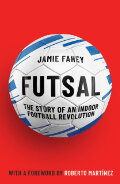My futsal story: from Liverpool streets to the indoor hall
EXCLUSIVE extract: Introductory chapter
THIS BOOK came about after my own voyage of discovery in the five-a-side game. At first glance, futsal seems to be a shrunken version of football – but in fact it boasts many more layers, creativity-inducing restrictions and tactical complexities. It’s a thinking player’s game, originating as a sport heavily influenced by various other games, including basketball and handball.
The book assesses the state of play within the sport, delving into its politics, history and global reach. I’ll also attempt to discover the soul of the game via the thoughts of its biggest characters – including professional footballers with a futsal background.
I’ve dedicated two chapters to figures who had a vital impact both on Everton (the club I support), and on my own thinking about sport: Wayne Rooney and Roberto Martínez. I also analyse the biggest skill transfers to the eleven-a-side game, and shed light on the intricacies of a small-sided sport that many football fans may have heard of, but precious few understand.
First, the basics: futsal is played with five players on each side, on a hard surface, usually indoors, and measuring anywhere from the size of a basketball court (28 metres by 15 metres) to that of a handball court (40m × 20m). Traditionally there are four on-court players and one goalkeeper, using a small, dense ball, hockey-size goals (3m × 2m), sidelines and end lines, with no restrictions on the height to which the ball can be played. There is no offside rule.
Futsal is a bona fide professional sport in its own right, as well as a renowned ‘laboratory’ for intense, focused fun – fuelling the skill sets of the best eleven-a-side footballers the world has ever seen.
“The futsal story is set against the backdrop of my own journey from street footballer in Liverpool.”
But it’s far from simply a reduced, micro version of eleven-a-side football.
In 2020, futsal is governed by the overseer of eleven-a-side football, the Fédération Internationale de Football Association (FIFA), and is played by at least 60 million people worldwide, according to the most recent count in 2016, making up 20 per cent of the 300 million total for all forms of football.
Brazil and the big Asian nations lead the way: an estimated 16 million adults and children play the game in Iran; in Brazil, where more people play futsal than football, the figure is thought to be 10-12 million.
In England, where conventional five-a-side has dominated – with the bouncy football, wide letterbox goals and side boards instead of lines – participation in futsal has never gone beyond the levels of a passionate cult. But it’s growing fast – particularly at youth level.
Globally, the FIFA statistics reveal a different story entirely: in 2018 two-thirds of its 211 nations – 140 countries – had a male futsal team and 55 had a women’s national side too. But FIFA’s version is not the only form of futsal played.
A rival global governing body, the Asociación Mundial de Futsal (AMF), acts as a successor organisation to the original governor of futsal, the Federación Internacional de Fútbol de Salón (FIFUSA), and makes bold claims about being more faithful to the original rules that evolved in South America in the decades before FIFA got involved in the 1980s. FIFA’s game is massively more popular than the AMF version, but the failure to establish futsal as an Olympic sport by 2020 is seen as a barrier to further growth.
The futsal story is set against the backdrop of my own journey from street footballer in the poverty-stricken streets of Liverpool in the 1970s and 80s, to semi-professional footballer and aspiring youth coach. A look back at my own childhood environment in Liverpool – at a time when both the city’s clubs were at the top of their game – reveals strong links to five-a-side and informal street play.
“My decade of exploration involved starting to play competitive amateur futsal at the age of forty.”
Liverpool FC’s five-a-side obsession (credited with propelling them to European glory in the late 1970s) is the stuff of legend. Perhaps less well known is Everton’s penchant for Brazilian-style head tennis under Howard Kendall, which I saw first-hand as a teenager at the Everton school of excellence. At ‘grassroots’ level in Liverpool, five-a-side was everywhere: on the streets, in youth clubs and parks – due especially to the unrivalled annual youth competition run by Merseyside Police throughout the era.
As well as taking coaching qualifications in futsal (to complement my football UEFA B award) and coach mentoring (for the English FA) in football, my decade of exploration involved starting to play competitive amateur futsal at the age of forty.
Quite simply, futsal offers the closest experience to my childhood street football buzz that I’ve ever encountered.
Have something to share? Add your comment below.









ENGLAND MEN’S futsal team is back. To mark the historic return, here’s an exclusive extract from Futsal: The Indoor Game Revolutionizing World Soccer focusing on the last time they competed in main round qualifiers